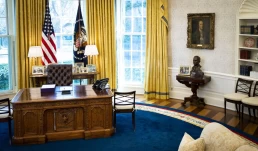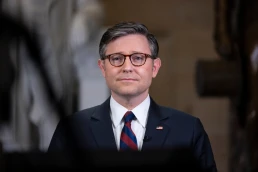We cannot build peace without the voices for peace in government.
By Kelsey Coolidge
At his inauguration in January, President Trump suggested that his greatest legacy will be that of a peacemaker and uniter. Many Americans voted for the President because they believed he would end U.S. involvement in foreign wars.
Exit polls show that foreign policy issues like the wars in Gaza and Ukraine influenced American voters in 2024. For example, one-third of voters reported that the war in Gaza, “was highly important in their choice of presidential candidate.” In the swing state of Michigan, Muslim voters rejected Harris in favor of third-party candidates or Trump.

Americans are tired of war. As a millennial, my life is bookmarked by the global war on terror, the loud wars in Iraq and Afghanistan, the quiet wars in places like Somalia and Yemen (where U.S drone strikes have killed thousands), and, today, the wars in Ukraine and Gaza. I’ve dedicated my professional life to non-partisan and non-profit work that analyzes the drivers of war and the opportunities for peace.
That work is under attack by the “peace” President. This dismantling of the United States Agency for International Development (USAID), the United States Institute of Peace (USIP), and incoming reports of a diminished State Department are proof that peace is not the priority. All signs point to a continued, escalated, bloated budget for U.S. military spending.
I think it’s important that we think critically about what can feasibly end wars and build peace. It matters how we understand these issues, what we demand of our current elected leaders, and how we choose new leaders in the future.
It starts with these questions.
Do you think we end wars by investing trillions of dollars in military spending?
Do you think we end wars by systematically gutting the only institutional voices for diplomacy, cooperation, dialogue, and conflict resolution (USAID, USIP, or State)?
I think this is a recipe for war.
Imagine what the decision-making process is in responding to a security crisis (a good book that shows insight to what this process looks like inside government is Thirteen Days by Robert F. Kennedy). A President brings together top advisors to weigh options. Military leaders come with a litany of military responses. Diplomats come with a litany of diplomatic responses. Usually, the response blends the two approaches.
If we’re only investing in military spending, the scales of the decision-making process are skewed away from diplomacy and other peaceful responses, increasing the probability of war.
Military leaders will come to the table with a vast workforce of analysts, intelligence officers, and strategists creating thoroughly vetted military solutions. They come with $trillions in weapons systems and an expansive global network of more than 800 overseas bases and ships primed for action—the means and capability for fast and deathly force.
Diplomats come to the table with far less: a depleted and demoralized workforce of foreign service officers, isolation from global allies who are less and less likely to play nice with us, the erasure of tools like development assistance and humanitarian aid, and cut-off from global institutions of influence, like the United Nations. They come to the table with fewer viable options.
More simply, when the tool you have is a hammer (the military), everything looks like a nail (a war).
We cannot build peace without the voices for peace in government. We also need strong voices outside of the government to advocate for pro-peace policies. Peace movements, non-profit or non-governmental organizations, and the charitable foundations that support them are all involved in this work. These civil society organizations do more to represent a war-weary American public than a government that cuts all funding for peace.
Kelsey Coolidge is the Director of the War Prevention Initiative of the Jubitz Family Foundation.
Recent Posts
White House Refuses To Rule Out Summary Executions Of People On Its Secret Domestic Terrorist List
December 15, 2025
Take Action Now The Trump administration ignored questions about whether it would order the killings of those on its NSPM-7 list — even while…
Koch Network Fuels Republican Push To Kill ACA Subsidies
December 15, 2025
Take Action Now As millions face higher premiums, Koch‑funded groups are pressuring Republicans to oppose Obamacare subsidy extensions.By Donald…
We’re Making ‘Tax the Rich’ More Than a Slogan
December 14, 2025
Take Action Now “Workers Over Billionaires” was the slogan on Labor Day. It should be the slogan every day.By Max Page, Labor Notes Taxing the…
‘Total Amateur Hour’: FBI Official Says Antifa Is #1 Threat in US—But Can’t Say Where, Who, or What It Is
December 13, 2025
Take Action Now “Just a complete admission here that the entire ‘antifa’ threat narrative is totally manufactured by this administration,” said one…




